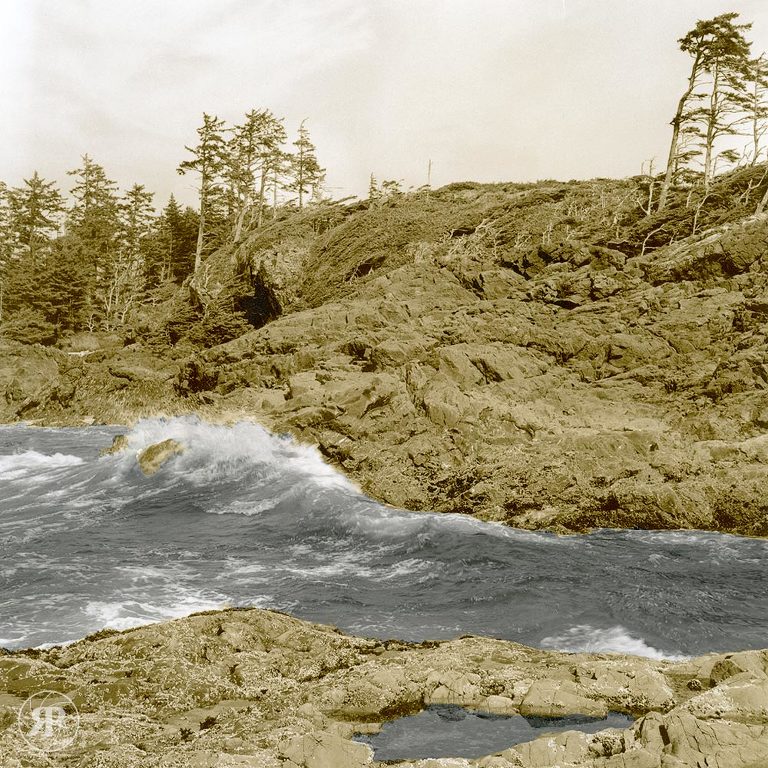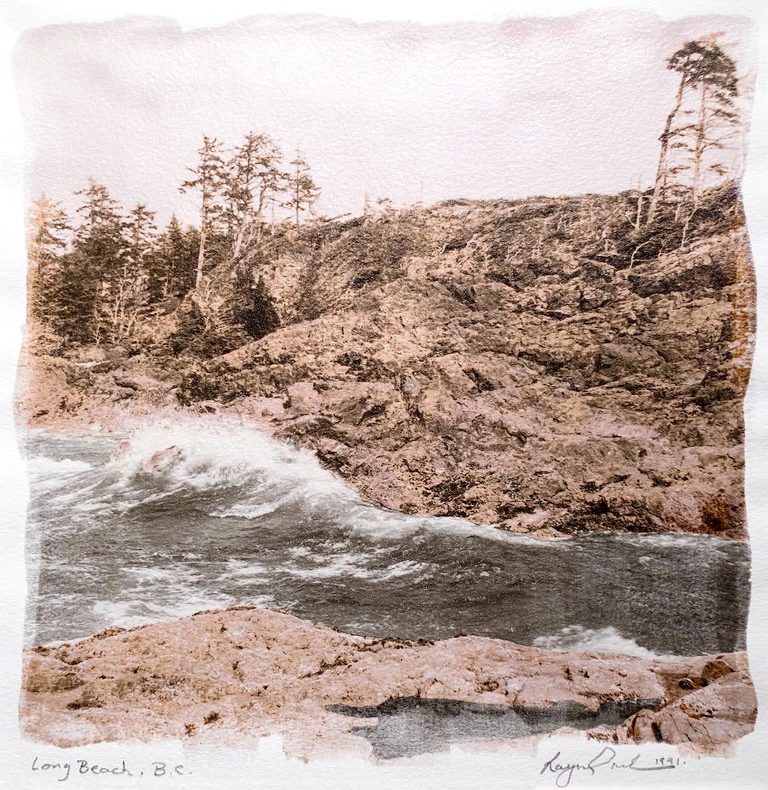Sometimes I must go back to the mountains; sometimes I must go down to the sea.
Both inspire photography; luckily I live in BC,
Where the sacred places and open spaces nourish the wild in me,
Where my inner nature boy comes out to play and for a time I'm free.For British Columbia is beautiful, like we boast on our licence plates,
From the glacial peaks of the Rockies to wild Pacific straits,
Where waves crash on ragged shores, gulls wheel and eagles soar,
And I am contentedly happy, with no need for anything more.

Long Beach, BC, 1985
I must go down to the seas again, to the lonely sea and the sky,
And all I ask is a tall ship and a star to steer her by;
And the wheel’s kick and the wind’s song and the white sail’s shaking,
And a grey mist on the sea’s face, and a grey dawn breaking.
Six years later, after a stint in the catalogue sweatshops of Toronto, I returned to the west coast, and for a short time found employment as an ocean kayaking guide, sometimes in the waters off Vancouver Island, near Tofino and around Barclay Sound.
I also returned to the Long Beach negative, experimenting with different print interpretations, including selective copper toning.
This test print, made on Ilford Multigrade RC paper, illustrates my first experiments masking with Windsor & Newton Art Masking Fluid.
Using watercolour brushes, I masked the water areas with the frisket, allowed it to dry, then copper toned the print. The relatively fast processing, especially reduced fixing and washing times, afforded by the RC paper allowed me to practice without spending days in the darkroom.
Test Print on RC Paper

I must go down to the seas again, for the call of the running tide
Is a wild call and a clear call that may not be denied;
And all I ask is a windy day with the white clouds flying,
And the flung spray and the blown spume, and the sea-gulls crying.
The next step included larger brushes, rag watercolour paper, and silver emulsion, with the intension of replicating early photographic printing processes, before the advent of manufactured photographic paper.
Early "printing-out" papers (a term coined in 1891 by Ilford) included salted paper, albumen (made from egg whites), gelatin-chloride and collodio-chloride, often mixed by photographers prior to printing. The preparation of light-sensitive papers was part science, part alchemy.
Though labour-intensive by today's digital standards, I opted for pre-prepared "Liquid Light" silver emulsion. I projected the negative onto the raw paper and marked the corners with a pencil. Under the darkroom light, I then poured emulsion onto the paper, spreading it out with a wide Japanese brush. The paper was then stored in the light-safe for drying. The easel and negative were left in place to assure accurate registration.
The second darkroom session consisted of exposing the prepared sheets of paper (I made around 8 for this image) fixing with hardening fixer, and washing.
Again, frisket was painted onto the sea and lower right tidepool, excepting the rocks in the wave, and the print was immersed in a copper toning bath, with time estimated from previous tests. After a wash, the frisket is removed.
Finally, after drying, Marshall's oils were used to add a slight green tone to the breaking wave (hard to detect in the accompanying scan).
Hand-coated, selectively-toned silver print on watercolour paper

I must go down to the seas again, to the vagrant gypsy life,
To the gull's way and the whale's way where the wind's like a whetted knife;
And all that I ask is a merry yarn from a laughing fellow-rover,
and a quiet sleep and a sweet dream when the long trick's over.~John Masefield
I think it's safe to say that a trip that started out with a bump, ended up delivering a potitive outcome.
Prints are available in Open and Limited Editions
Recent Comments
- Classic Film Review Blog – Kodak Recording Film 2475 – Alex Luyckx | Blog on Remembering Recording Film 2475
- Raymond Parker on Shell Gas Station, West 10th & Discovery, Vancouver, 1986
- Regan on Shell Gas Station, West 10th & Discovery, Vancouver, 1986
- 1093 The militant mothers of Raymur – The Ormsby Review on Raymur Bridge, AKA Keefer Street Overpass, AKA The Militant Mothers of Raymur Pedestrian Overpass
Contact
Raymond Parker Photo
6395 Riverstone Dr.
Sooke, BC,
Canada V9Z 1N4
PH: (250) 896-7623
Newsletter
© 2025 Raymond Parker Photography
















